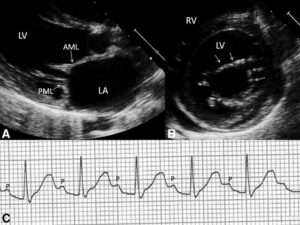
It is an acute inflammatory disease occurs due to infection by group A hemolytic streptococci which involves heart, joint, skin and nervous system which develops as autoimmune reaction to infecting organism.
Etiology
1. Predisposing causes
a. Age should be 5 to 15 years
b. Sex has equal incidence
2. Genetic factors: Family incidence known.
3. Social and economic factors: Dampness, overcrow- ding and under nutrition increases incidence.
4. Idiosyncrasy is presumably a factor since 3% of people are involved in streptococcal epidemics develop rheumatic fever.
Clinical Manifestation
a. Prodromal phase: Tonsillitis or sore throat 1 to 4 weeks prior to onset of acute rheumatic fever. Besides this anorexia, pallor, fatigability and nervous irritability is present.
b. Latent phase: When antibodies to preceding streptococcal infection are produced.
c. Phase of onset of rheumatic fever/Mode of onset. Arthritis and fever 2 to 3 weeks after infection.
d. Cardiac symptoms 3 to 6 weeks after infection is first to draw attention.
e. Abdominal symptoms: Abdominal pain and tenderness, nausea, vomiting, fever and leucocytosis.
f. Pyrexia of unknown origin
g. Typhoid or influenzal mode of onset with fever
h. Nodules of skin lesion.
Investigations
1. Saliva culture
ii. ECG: P-R interval is prolonged.
iii. ESR increases
iv. X-ray chest shows cardiac enlargement .
Diagnosis
Diagnosis of rheumatic fever is made by Jones criteria’ which is as follows:
1. Carditis
It is pancarditis involving endocardium, myocardium and pericardium.
It manifests as breathlessness, palpitation and chest pain.
Tachycardia, cardiomegaly and new or change murmurs.
Aortic regurgitation in 50% cases.
Pericarditis produces frictional rub and pericardial tenderness.
Cardiac failure due to myocardial infarction.
2. Sydenham’s Chorea
Late neurological manifestation that occurs at least three months after the episode of ARF when all signs disappear.
More common in female.
It is characterized by involuntary dancing movements of hands, feet or face.
3. Arthritis
Early feature of illness and is non-specific.
It is characterized by acute painful symmetric and migratory inflammation of large joins.
4. Erythema Marginatum
Red macules which fade in centre but remain red at the edges and occur mainly on trunk and proximal extremities on face.
5. Subcutaneous Nodules
They are small, dense and firm and painless and are best felt over tendons and bones.
Nodules appear more than 3 weeks after onset of other manifestation.
Treatment of Acute Rheumatic Fever
a. Benzathaine penicillin 1.2 mu IM 4 hourly. If patient is allergic to penicillin, erythromycin 40-50 mg/kg for ten days is given.
b. Aspirin usually relieves symptom of arthritis rapidly. A starting dose of 60 mg/kg body weight per day is given divided into 6 doses. The dose may be increased to 120 mg/kg body weight. This dose may produce severe symptoms like vomiting, tachypnea and acidosis. Aspirin is given till ESR comes to normal.
c. Corticosteroids like prednisolone produces rapid symptomatic relief than aspirin and is indicated in cases with severe arthritis or carditis. Prednisolone is given in doses of 1.2 mg/kg body weight till ESR comes to normal.
d. Bed rest is important to reduce joint pain and cardiac workload. Duration of bed rest is guided by markers of inflammation like temperature, WBC count and ESR.
II. Secondary prevention: To prevent further attack of rheumatic fever, long term prophylaxis is needed.
a. Benzathaine penicillin 1.2 mU IM is injected at the interval of 21 days. Further attack is unusual after the age of 21 years and treatment can be stopped.
b. To prevent chances of endocarditis prophylactic antibiotic therapy should be given.